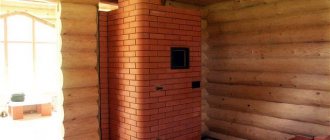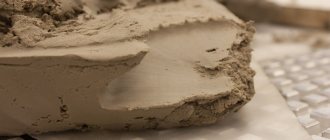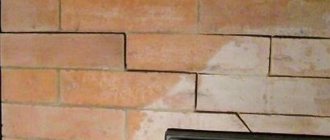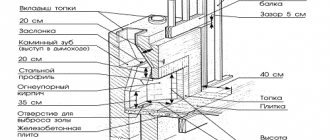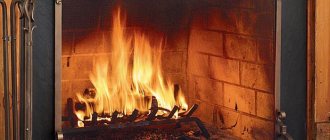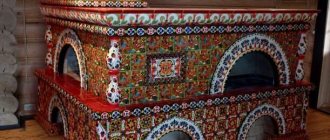The fireplace must be laid in accordance with special requirements, since during operation there will be constant contact with high temperatures. Therefore, ordinary concrete solutions are not suitable in this case. It is necessary to use special ones, the composition of which will be heat-resistant, durable and at the same time elastic, since when heated, all components increase their shape, and when cooled they must return to their original state, without cracks or destruction.
Indicators of properties of refractory masses
When laying tiles and fireplaces, specialists use heat-resistant clay mortar. Chamotte is a fireproof type of clay, which is the main component of the mixture; in addition to it, there is sand, cement, synthetic plasticizers, and water.
This composition is used for brick or stone masonry, but it is not entirely convenient for cladding, since when applied to a horizontal surface it begins to slide and hardens for quite a long time. This can lead to asymmetrical lines and thick seams, which will ruin the appearance of the fireplace. Therefore, the use of special glue is recommended for cladding.
What is glue for stoves and fireplaces?
A viscous solution that provides quick bonding of tiles and decorative elements of a fireplace installation is called glue. It can be sold in a ready-made version and in the form of a dry mixture. The first should be used when there is some skill in cladding and the process will be quick.
Because the liquid solution tends to harden quickly, and if the laying of tiles is delayed too much, it may deteriorate and be unsuitable for further use. In addition, ready-made glue will cost several times more than the dry mixture, which is not difficult to prepare; you just need to mix it with water in the right proportion.
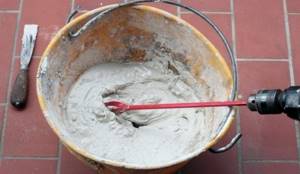
Preparation of mortar from dry building mixture
How to dilute the dry mixture is indicated on the packaging or in the instructions. You can make the solution in small volumes, which will be consumed within an hour of work. This way, the glue will not have time to harden and the quality of the masonry will not deteriorate.
What do the main parameters say?
Many novice craftsmen mistakenly believe that indicators such as heat resistance, thermal strength, heat resistance and fire resistance are synonymous with one parameter. Then, if they use a universal product in which all these characteristics are expressed to a high degree, they may simply be lucky and the hot-melt adhesive will cope with all the functions. Professional craftsmen distinguish between these terms and manipulate these parameters, selecting the composition for various types of work.
- Heat-resistant adhesive is capable of maintaining technical properties at temperatures above 140°C for several hours.
- Thermal-resistant material must retain its qualities for a long time.
- The heat-resistant material increases the temperature level of heat-resistant adhesive by 10 times.
- Heat resistance – the ability to maintain qualities under prolonged exposure to temperatures above 1000°C degrees.
- The fire-retardant composition comes into direct contact (open contact) with the flame itself for several hours.
- Fireproof adhesive is adapted to long-term contact with fire.
Good to know: Installation of a fireplace with air heating, how to make it yourself
If the adhesive composition has only certain characteristics that are clearly expressed, then such a material is suitable for performing a narrow range of work.

Mixture under the brand name Terracotta
Heat-resistant and fire-resistant mixtures are used when laying fireclay bricks in the firebox itself. They form a durable solution that, when dried, has high adhesion and can withstand critical temperatures without cracking. Heat-resistant compounds are often used for laying stoves in heat exchange areas or in the labyrinths of a brick chimney.
Inexperienced craftsmen often come up with suggestions to use heat-resistant glue in all types of work, as it has the highest performance. Such an idea can be formulated from a lack of understanding of the basic processes that occur in a stove or fireplace during their operation.
Some contacting surfaces (fireplace walls and their lining) have different expansion coefficients. The connecting link can only be an elastic material, which is not heat-resistant glue. After drying, heat-resistant mixtures are able to deform without destruction under the influence of external forces. This adhesive is suitable for cladding the fireplace frame, as a tile mortar or in places where the temperature does not exceed 140°C degrees.
Composition of facing adhesive
Manufacturers are trying to make glue compositions as universal as possible, but at the same time improve some qualities:
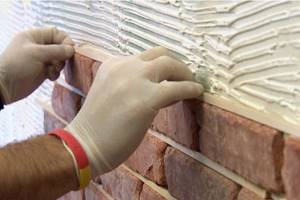
Installing tiles using heat-resistant cladding adhesive
- heat resistance;
- moisture resistance;
- plastic;
- heat exchange;
- linear expansion;
- environmental friendliness.
To do this, various synthetic components are added to the composition, ensuring the performance of the above functions with a predominance of several. Those compositions that meet all the criteria are considered universal, for example, Profix, Scanmix Fire, Terracotta, their cost will be correspondingly more expensive. We can distinguish the main components that are present in all adhesive mixtures:
- cement;
- sand;
- fireclay fibers;
- mineral components;
- synthetic additives.
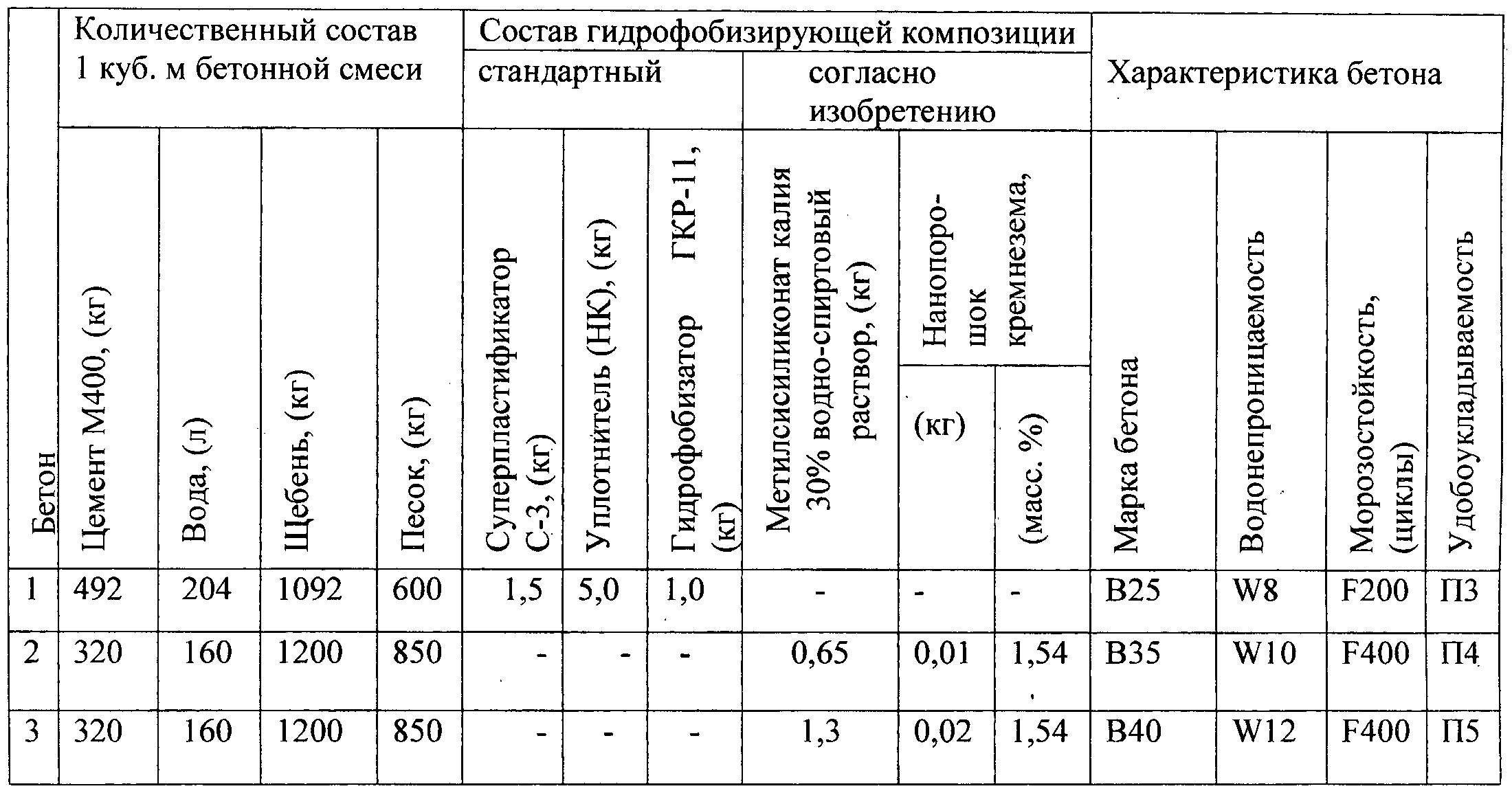
Cement provides strength, minerals provide plasticity, fireclay fibers provide heat resistance, and synthetic components provide moisture resistance, heat transfer, and linear expansion. The predominance of a certain component can increase one characteristic, but at the same time negatively affect others. Therefore, there are two types of glue for fireplaces:
- for finishing the portal;
- for basic brick or stone masonry.
How to choose
The composition should be selected taking into account several important criteria:
- Where will the stove be located, indoors or outside the house? The heat-resistant composition can withstand up to +1200° C, but pay attention to the lower limit. A stove located outdoors must be resistant to frost and off-season climatic conditions.
- Before purchasing, carefully read the instructions for use of the composition. Only a mixture with fire-resistant properties is suitable for working with the firebox.
- The same composition is not suitable for different finishing materials, so first decide on the finish and only then select the glue.
- The heat-resistant mixture should be applied in a thin layer, so pay attention to differences in the plane. If there are a lot of them and they are significant, then choose a composition that is thicker in consistency (with higher viscosity values), this will smooth out the unevenness.
- When choosing, pay attention to the properties of steam and water resistance, especially if the stove is built in a bathhouse.
- Toxicity indicators are also fundamentally important. Under different operating conditions of the structure, foreign odors may appear, which, among other things, may be unsafe for human health. Information about the toxicity of the mixture is available on the packaging.
Glue for laying the base of the fireplace
Mixtures for fireplaces mainly contain clay and cement; they are less plastic, which is why their use for cladding is not recommended. This mixture is best used for laying fireclay bricks, since they are similar in composition, which means they will behave the same during heating.

Plitonit SuperFireplace
This effect is called linear expansion; under the influence of high temperature, all substances change shape - they expand, and after cooling they narrow to their original position. If the composition is the same, then the percentage of expansion/contraction will be the same, and the likelihood of cracks will decrease.
Porcelain tiles for the stove
If an existing heating structure is installed in the room, it must be finished with fire-resistant materials. Porcelain stoneware is best suited for this. To fix it, mastic or other heat-resistant means are used.
The material contains plaster, sand and several types of clay. It should be noted that porcelain stoneware does not emit harmful substances when exposed to high temperatures, therefore it is absolutely safe for health.
Peculiarities:
- Today there is a huge selection of this material, as it is in demand among consumers and construction companies. Porcelain tiles can be made in various design styles. In addition, it imitates many natural analogues.
- If necessary, you can choose a glossy or matte artificial stone structure. When purchasing, you need to take into account that the material has small pores that can cause stains to appear on the surface.
- Porcelain stoneware is made by pressing the necessary ingredients followed by firing in several stages. This allows you to achieve the required strength.
Porcelain tiles have a number of advantages:
- Moisture resistant. This is achieved through a special layer that absorbs water. In addition, this coating performs a protective function against chemicals.
- No special care is required, this is achieved thanks to the practical surface.
- Double firing and the use of modern technologies make it possible to achieve maximum strength of the material, making it resistant to mechanical damage.
- Porcelain tiles can last twenty years. Due to this indicator, it is often used for finishing various surfaces.
- Even after long-term use, the surface does not wear out and retains its original appearance.
- Easy installation.
- Resistance to sudden changes in temperature.
- Due to its heat-resistant properties, it is often used to finish stove structures.
When purchasing porcelain tiles, you must ask for the appropriate certificate that meets the necessary standards. If possible, you should visit the room where it is stored, since its quality depends on the conditions. The tile should be smooth with even corners. If you need high-quality finishing of the surface of the stoves, then you need to choose an artificial stone without the slightest defects.
Fireproof adhesive for fireplace cladding
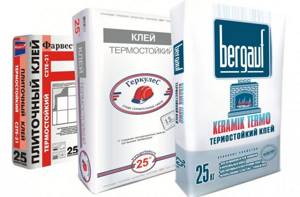
Stove adhesive
If it is necessary to line the fireplace with decorative tiles or stone, then it is necessary to use glue specially designed for this. The composition is dominated by mineral components, which provide high plasticity and adhesion - adhesion of surfaces. As a result, the likelihood of tiles falling off during the operation of the fireplace is reduced.
For cladding, in addition to clay-based glue, a heat-resistant solution of soapstone powder with liquid glass is often used. Soapstone is a natural stone, also called soapstone, and contains talc, magnesite and chlorite. Crushed stone is used for glue; the fractions must be very small so that the connection with liquid glass is uniform.
This glue is also called Finnish, it is distinguished by high heat transfer, thanks to which the fireplace will heat the room faster, as well as by its plasticity and elasticity under the influence of high temperature.
Tips for use
For poorly absorbent substrates, it is also recommended to treat with a specially designed composition.
Prepare the surface a couple of days before the start of facing work. When working with dry mixtures, you need to prepare the surface and wait about an hour. The glue is diluted with clean water in a ratio of about a quarter liter per kilogram of dry mixture. When mixing, it is best to use a drill or a special stirrer to avoid the appearance of clots and lumps. The algorithm for working with glue is as follows: using a spatula, apply the composition to the desired surface and smooth it around the perimeter. Next, the tile is pressed (it can be corrected within about fifteen minutes after gluing)
It is important to remember that the thickness of the applied mixture should not exceed more than one centimeter.
Adhesive with thermal properties has long taken one of the leading positions among adhesive mixtures. It can be used, for example, for ceramics, durable cast iron, glass ceramics and rubber. It has proven itself well in everyday life. For example, according to the instructions for use, it can be used to process various parts of the oven. Thanks to the ability to maintain strength, durability, ductility and high adhesion, regardless of temperature fluctuations, this material has truly become indispensable in construction and repair work.
You can learn how to tightly glue various materials together from the video below.
Popular brands of glue for stoves and fireplaces
Today, manufacturers offer a wide variety of adhesive options for stoves and fireplaces. Among the most popular and in demand dry mixtures are the following:
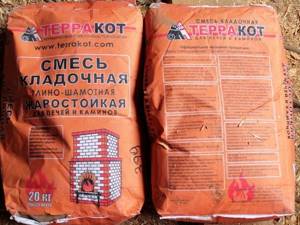
Heat-resistant reinforced adhesive Terracotta
- Terracotta is heat-resistant (up to 250°), characterized by increased adhesion. Used for tiles or natural stone, not suitable for fireplace bases. The cost of glue is 550 rubles;
- Profix - intended for both masonry and portal finishing, it is characterized by high plasticity, due to which it allows you to make a thin layer of masonry. The maximum permissible heating temperature is 1200o. Cost – 455 rubles;
- Scanmix Fire is a heat-resistant adhesive from a Finnish manufacturer, designed for laying solid fuel fireplaces and stoves, chimneys. The maximum heating temperature is 1200o. Cost – 600 rubles;
- Ivsil Termix is a facing adhesive that is used only for durable substrates. It is characterized by high plasticity and can withstand heating up to 250°. Cost – 460 rubles;
- Ceresit Flex CM 16 is a fairly common brand of facing adhesive; it has gained popularity due to the ability to lay tiles on an uneven base. Cost – 600 rubles.
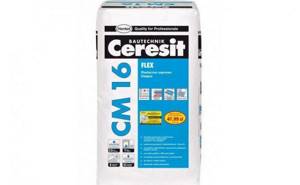
Tile adhesive Ceresit CM 16 Flex 25 kg
If we consider ready-made adhesive mixtures, we can distinguish the following:
- Parade K-77 - characterized by increased fixation, fireproof, able to withstand heating up to 800o, but is not intended for plastered surfaces. Cost – 300 rubles per 15 kg;
- Tarracotta Mastic is a universal adhesive that can be used for finishing fireplace portals, stoves, brick or stone masonry. The maximum heating temperature is 1100o. Cost – 220 rubles per 5 kg;
- Mixonit Termo is a facing mastic that can be used for outdoor stoves; it does not deform at high humidity and temperatures down to -30°. Country of origin - Germany, cost - 1130 rubles per 14 kg.
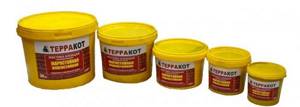
When purchasing any glue, either ready-made or in the form of a dry mixture, you must pay attention to the production date; an expired mixture can negatively affect the quality of installation and cladding. The packaging of dry glue should not be damaged, wet or otherwise deformed.
[ads-pc-2][ads-mob-2]
Which one should I take?
Knowledge of the physicochemical properties of the oven adhesive base greatly simplifies its choice, but it is also necessary to keep in mind the scope of application specified by the manufacturer. For example, Terracotta Superfireplace is a good masonry adhesive, but the manufacturer guarantees the reliability of the cladding on it only if it is also made of terracotta tiles. The base of the Terracotta Superfireplace is clay-cement-fireclay, and therefore facing materials need to be placed on it in belts of 2-4 rows with breaks for the glue to set. How to line a stove with terracotta, see next. video:
Video: finishing the stove with terracotta
Glue Plitonit SuperKamin Ogneupor can also be used for masonry, it is a good heat-resistant adhesive for the oven, but the best domestic one for this purpose is K-77, which is essentially an oven masonry adhesive based on aluminosilicates. Besides the expensive ScannMix , it is perhaps the only option for laying the base of a fireplace/stove, because... maintains high sub-zero temperatures, does not allow moisture and its vapors to pass through.
Profix , Hercules and Ivsil termix adhesives are intended for tiles, but the first according to TKR “specializes” in tiles, Hercules is suitable for any cladding of a fireplace or stove tent, incl. heavy (natural stone), and Ivsil termix has proven itself well on the portals of wood-burning fireplaces with fireclay open fireboxes. As for Polymin P11 and Ceresit C16 and C17, these are heat-resistant general purpose adhesives; the lining on them holds tightly only if the fireplace has a factory-made metal firebox with glass.
Note: there is a fairly wide selection of tile stove adhesives of Belarusian and Ukrainian production on sale. However, the upper limit of heat resistance of the former is, as a rule, 180, and for the latter 150 degrees, which is sufficient, at best, for cladding a fireplace tent with a finished closed firebox. Are they saving on raw materials, or what?
Requirements for heat-resistant adhesive
All heat-resistant compositions meet the following requirements:
- The composition must be fire resistant, since fireplaces and stoves are constantly exposed to open fire.
- Steam and water permeability is a significant point when using a stove in bathhouses.
- Increased flexibility helps maintain structural integrity.
- Due to the content of fibers in the composition, the adhesive is used for fastening the plaster mesh.
- Temperature resistance concerns not only the maximum limit, but also the lower limit, since often fireplaces and stoves can be located in unheated rooms.
How to Carefully Apply Heat Resistant Sealant
To make it convenient to repair a stove or chimney using sealant, you need to prepare some tools and materials.
So, you will need:
- Construction mounting gun or syringe.
- Rubber spatula.
- Stationery knife.
- A gas burner and, accordingly, a refilled cartridge for it.
- Sealing compound in the cartridge.
- Masking tape.
- Latex gloves.
In the case when the paste is purchased in a tube, a construction syringe is not required, and when using a heat-resistant sealant, there is no need to prepare a burner and a gas cylinder for use.
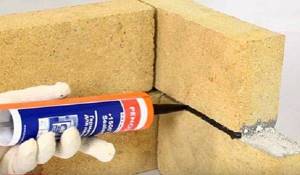
Sealing joints between bricks requires special care
When applying sealant to surfaces, special care is required when filling seams or cracks, especially if it is necessary to maintain the neat appearance of the masonry, made “for jointing”
To carry out such work efficiently, it is advisable to take into account a couple of tips from experienced craftsmen:
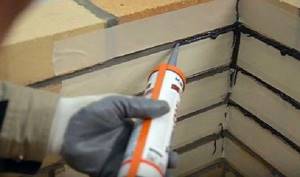
In order not to stain the surface of the brickwork with sealant, a reasonable solution would be to seal it with masking tape, leaving only gaps along the line of the seams being sealed.
To prevent the sealant from getting on the surface of the brick and filling only a crack or seam, the surfaces can be sealed with masking tape of the required width. The tape is glued along the seam line, then the gap is filled with sealing paste, approximately one centimeter deep. If necessary, the sealant is leveled with a rubber spatula and there is no need to be afraid that the dark composition will stain the surface of the wall. After the paste has set, the tape is removed. This method will allow you to keep the seams in their original width and not spoil the neat appearance of the brickwork with dark paste.
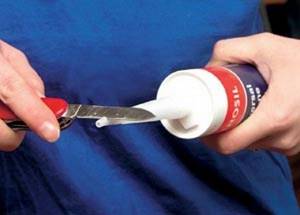
The tube spout is cut so that the hole is slightly beveled, and its diameter is slightly less than the width of the seams being sealed.
You can solve this problem in another way, without using tape. To do this, when preparing the tube for work, you should not immediately cut off its spout to the maximum. In addition, the cut should be made at a slight angle and so that the hole is 2-3 mm smaller than the width of the seam - this will help control the amount of sealant squeezed out. True, with this approach there remains a risk of accidental contact of the composition with the surface of the brick, so using adhesive tape is definitely the best solution.
Having taken into account these recommendations, you can proceed directly to the process of applying the sealing composition. The work is carried out in the following order:. The first step is to cut off the sealed cap that closes the tube from the cartridge using a sharp knife
The first step is to cut off the sealed cap that closes the tube from the cartridge using a sharp knife.

This cap is cut off completely, across its entire width.
- Next, a spout is screwed onto it, which is already cut as recommended above
- The next step is to install the tube into a mounting gun, which is prepared for work in accordance with the specific features of its design.
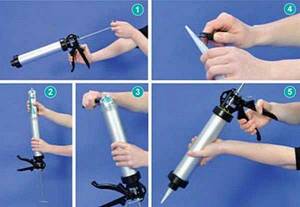
When working with a mounting gun, you must rely on the instructions for its use - there may be differences
Next, before applying sealant to the seam, crack or gap between the brick and the cast iron part, the surface must be carefully prepared:
- Clean from dust and dirt.
— A surface that is too smooth must be treated with sandpaper to increase adhesion, and then cleaned again.
— After this, the surfaces are degreased and completely dried. To speed up this stage of work, you can use a hair dryer for drying.

Filling the seam between bricks with heat-resistant sealant
- When the surface is dry, you can begin to fill the gap with a sealing mixture.
- Further, if a heat-resistant paste was used for sealing, then it is left to dry for a while. The packaging usually indicates the exact duration of the drying period for the sealant before the next stage of work can begin. Usually this period is about a day.
After the composition has hardened according to the instructions, it is recommended to burn it with a gas burner flame
The final step is firing the hardened layer of sealant using a portable gas burner. After such treatment, the material will be able to withstand temperatures of up to 1500 degrees during operation.
Of course, only one of the commercially available sealants was shown as an example. For other compositions, there may be some differences in application technology. In any case, you must carefully study the instructions supplied by the manufacturer.
